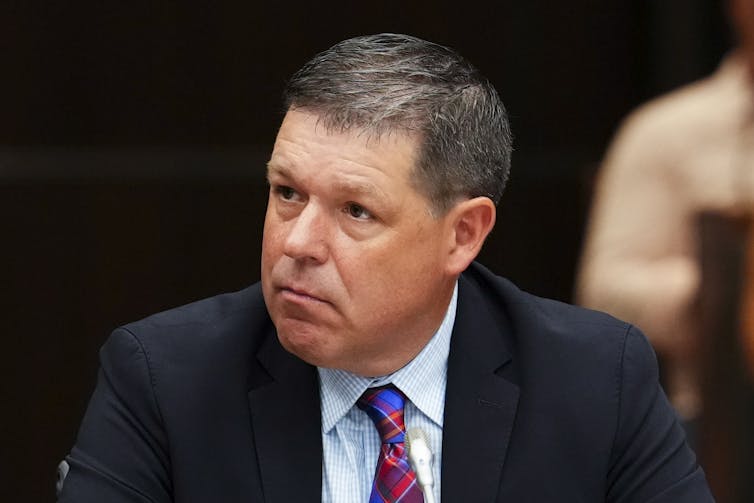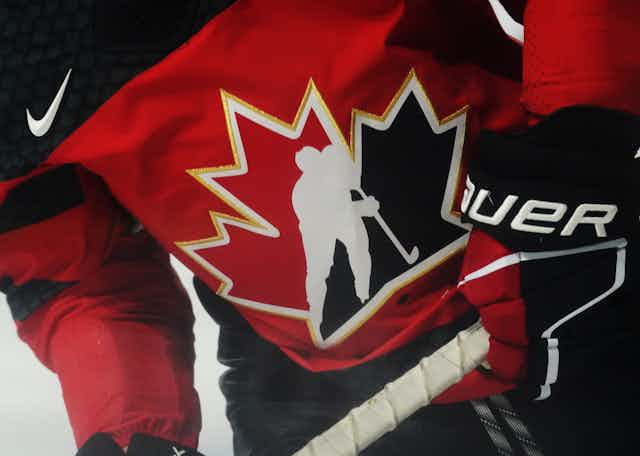Five hockey players from Canada’s 2018 gold medal-winning world junior team are facing charges in connection with an alleged group sexual assault of a woman after a gala event in London, Ont. six years ago.
Lawyers identified their clients as current and former NHL players: Michael McLeod and Cal Foote of the New Jersey Devils; Dillon Dubé of the Calgary Flames; Carter Hart of the Philadelphia Flyers; and Alex Formenton, currently of Swiss team HC Ambri-Piotta and previously of the Ottawa Senators.
The players’ lawyers have released individual statements saying their clients are innocent or will plead not guilty.
London police say they will hold a press conference about the investigation on Feb. 5.
Regardless of what follows, it has become increasingly clear that charges of sexual assault can no longer be silenced or swept under the rug in sport and other contexts.
Hockey Canada paid a still-undeclared settlement to E.M., the claimant in a $3.55 million sexual assault lawsuit against members of the 2018 world junior national team. Another $6.8 million was devoted to settlements related to Graham James, the junior hockey coach convicted of sexually assaulting young players he coached in the 1990s.
Hockey Canada has spent a total of $8.9 million on 21 sexual abuse settlements since 1989. Of that total, $7.6 million came from membership fees and the investment generated by the National Equity Fund, and $1.3 million came from its insurance. Hockey Canada has since announced it will no longer use funds from membership fees to settle sexual assault claims.
More than a few bad apples
Psychologist Philip Zimbardo’s “Lucifer Effect” contends that, when dealing with abuse, it’s not just a matter of removing a few “bad apples” — often, the whole barrel is spoiled. The entire barrel-making system must be re-engineered to produce only the finest barrels to hold and preserve apples with integrity.
Sport safeguarding advocates argue that, while efforts like the recently announced Future of Sport in Canada Commission may address systemic issues by re-engineering sport leadership and governance structures, the remaining bad apples will continue to abuse power, derailing real change in Hockey Canada.

Those who abuse their power and benefit from power imbalance will exert that power to preserve the status quo. Researchers have identified that the typical leadership responses to abuse claims include complicity, collusion, control and cover-up.
There is evidence of this within many Canadian national sport organizations attempting change, including Hockey Canada, Gymnastics Canada, Rowing Canada, Soccer Canada and Bobsleigh and Skeleton Canada.
According to Zimbardo’s theory, leaders must remove the bad apples while addressing systemic issues — only then will they be able to create and maintain quality, lasting barrels. Otherwise, the existing bad apples will poison the new, rotting the barrel from the inside.
Power in Canadian hockey
Hockey Canada has seen wholesale change with the resignation and reconstitution of both the CEO and board of directors. The new CEO was appointed in September 2023, but it’s important to note that new does not necessarily mean different.
Sexual assault is an abuse of power. One could argue that the culture of misogyny and sexual assault evident across hockey environments is a product of power abuse normalized across the hockey world:
- Coaches hold power over athlete careers
- Hockey Leagues hold power over coach careers
- Funders hold power over CEOs
- Veterans hold power over rookies
- Men often hold power over women
Though often well-intentioned, power imbalanced structures and hierarchies allow individuals and groups to abuse their power. Power imbalance is often sought and preserved as a misguided means to achieve stability, security, dominance and control.

However, the lack of independence can also lead to a lack of transparency and concrete accountability processes, resulting in a recursive cycle of abuse and corruption — a phenomenon that has been well-documented in academic, media and government reports.
Fixing the sport system
Sport Canada leaders must remove the bad apples while re-engineering a new power-balanced sport system grounded in independence, transparency and accountability. We need only look to best practice in sport itself as the blueprint for the Canadian sport system as a whole.
Independence must be built into the system by separating evaluation and education from qualification. Great coaches educate and evaluate athletes, but an independent body determines qualification based on gold medal standards.
For instance, the International and National Olympic Committees determine the qualification standards for the Olympics and the international federations research and provide gold medal standards for each sport.
National sport organizations should be guided by their international federations to adopt well-researched performance targets, criteria and measures, all of which should be made publicly available. Sport Canada should then use these criteria to hold national sport organizations accountable.
Greater transparency needed
Too often, coaches and organizational leaders obscure criteria and procedures to allow for subjective decision-making. An excellent coach posts performance targets, criteria and measures early and often, and athlete performance outcomes daily and publicly.
This approach can be scaled to fit any kind of sport organization or group. Sport Canada must ensure evaluation criteria are comprehensive, public, objective and grounded within standards of practice.
Transparency creates a partnership model of shared goals and collaborative process, rather than a power-imbalanced model of authoritarian control and compliance.
Sport Canada needs accountability
Accountability demands concrete demonstrations of change. Sport Canada has been chastised for implementing superficial box-checking processes such as the Canadian Sport Governance Code and report-card system, which has since been discontinued.
When boards of directors do not provide both advisement and a clear accountability framework, it is easy for CEOs or executive directors to abuse their power.
According to sound governance principles, Sport Canada needs to create a robust accountability framework that demands verifiable evidence of policy implementation and achievement of standards of practice as a condition of funding.
To build sport organizations, structures, policies and processes that are safe, healthy and high-performing, the power balance of the system as a whole must be re-engineered and those inclined to abuse power must be removed.
Those who inflict harm must also be removed and criminally charged based on the law. Others who cover up abuse or are neglectful bystanders must be held to the same standards. Only through a commitment to independence, transparency and accountability can sport bodies become a space that champions not only excellence but also the well-being of all its participants.

